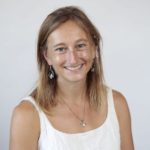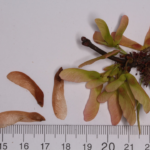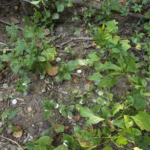This project calls for the identification of biological factors contributing to the regeneration dynamics of Overton Park. Professor Massad and students are searching for bottlenecks that may occur during different stages of seed growth.
The old growth forest in Overton Park is a natural asset to both Rhodes College and the Memphis community at large. Urban forests, however, are threatened by isolation, low genetic diversity, and invasive species, all of which can result in low recruitment of new seedlings that sustain the forest. In the case of Overton Park, poor forest regeneration has been observed since the 1980’s (Guldin 1987), and the operations manager at the Overton Park Conservancy is concerned about the lack of seedling recruitment. Typically, high light environments in tree fall gaps enable seedling growth and are part of natural forest functioning. Seedlings establishing in gaps will form the next cohort of trees that maintain forest structure and diversity, but in Overton gap succession appears to be arrested.
Understanding how Overton’s old growth forest is functioning is therefore of conservation concern and is also relevant to the park’s diverse users. To address this issue, research students, a community volunteer, and the lab section of conservation biology (Biol 320) have worked with Dr. Massad to set-up monitoring plots in Overton Park. This has been the beginning of a long-term project to understand regeneration dynamics in urban forest gaps. Students and Dr. Massad looked for bottlenecks in the recruitment process throughout the stages of seed arrival, seed germination, and seedling establishment. Seed-traps were used to monitor the diversity and abundance of seeds present in gaps and closed forests. Collected seeds were identified, counted, and planted in a greenhouse to determine their viability; seedlings were also tagged and monitored to determine if seedlings were not surviving well.
Data demonstrates potential differences in seed and seedling diversity, abundance, and survival in and out of gaps in the forest. Results have been used by Overton Park’s operations manager to make decisions regarding stewardship and to inform adaptive management. Increased knowledge regarding seeding recruitment in one of Memphis’ most beloved urban forests has therefore a major contribution of this work. Digital publications and field guides have been produced that are useful to both ecologists and the public. One of the major challenges in this research was identifying seeds. Seed identification books are rare and offer black and white images for identification. In addition, these resources are not in the form of keys but are merely collections of photographs (Montgomery 1978; Martin and Barkley 2000). Therefore, another important goal of this project was to make keys with high quality images of seeds and seedlings.
This work addressed multiple objectives of the Mellon Faculty Fellowship Program and has offered students opportunities for research and lab class activities. Research students learned about experimental design, data collection, and monitoring skills. Students from the conservation biology lab gained field experience and used their data to learn statistics important to describing biodiversity. Through this research, students were exposed to the work of the Overton Park Conservancy and collaborated with the operations manager. This was an excellent example of applied science informing conservation; such direct communication is unfortunately rare between scientists and practitioners.
Students also learned to take macro photos of the seeds and seedlings. Macrophotography is a skill valued by taxonomists, and students curated the photos into online keys seeds and seedlings of native trees. This has benefited the Overton Park Conservancy, community members, local conservationists, and ecologists. The combination of scientific research and targeted outreach products extended this project beyond the traditional academic realm and offered student fellows relevant research and community engagement opportunities.
Overall, this work was of scientific interest and improved students’ learning experience in conservation biology by offering them a chance to participate in actual research. Dr. Massad typically studies tropical forest functioning and seedling recruitment, but she was excited to extend her research to a local ecosystem in need of conservation attention. This project not only allowed her to introduce students to ecological fieldwork, it also helped her become involved in conservation in Memphis. Dr. Massad shared this work with the community of practice by demonstrating the value of integrating local ecosystems into the learning process. She has also improved her teaching by learning how other faculty have extended their classrooms into the community and used digital tools to enhance learning.
The conservation biology syllabus indicated the lab periods dedicated to this research. In the past year students continued their involvement, and the activities evolved with the needs of the project.


Tara Massad
Assistant Professor of Biology and Environmental Studies and Sciences
Dr. Massad studies tropical forest diversity and is deeply concerned with conservation and restoration.





